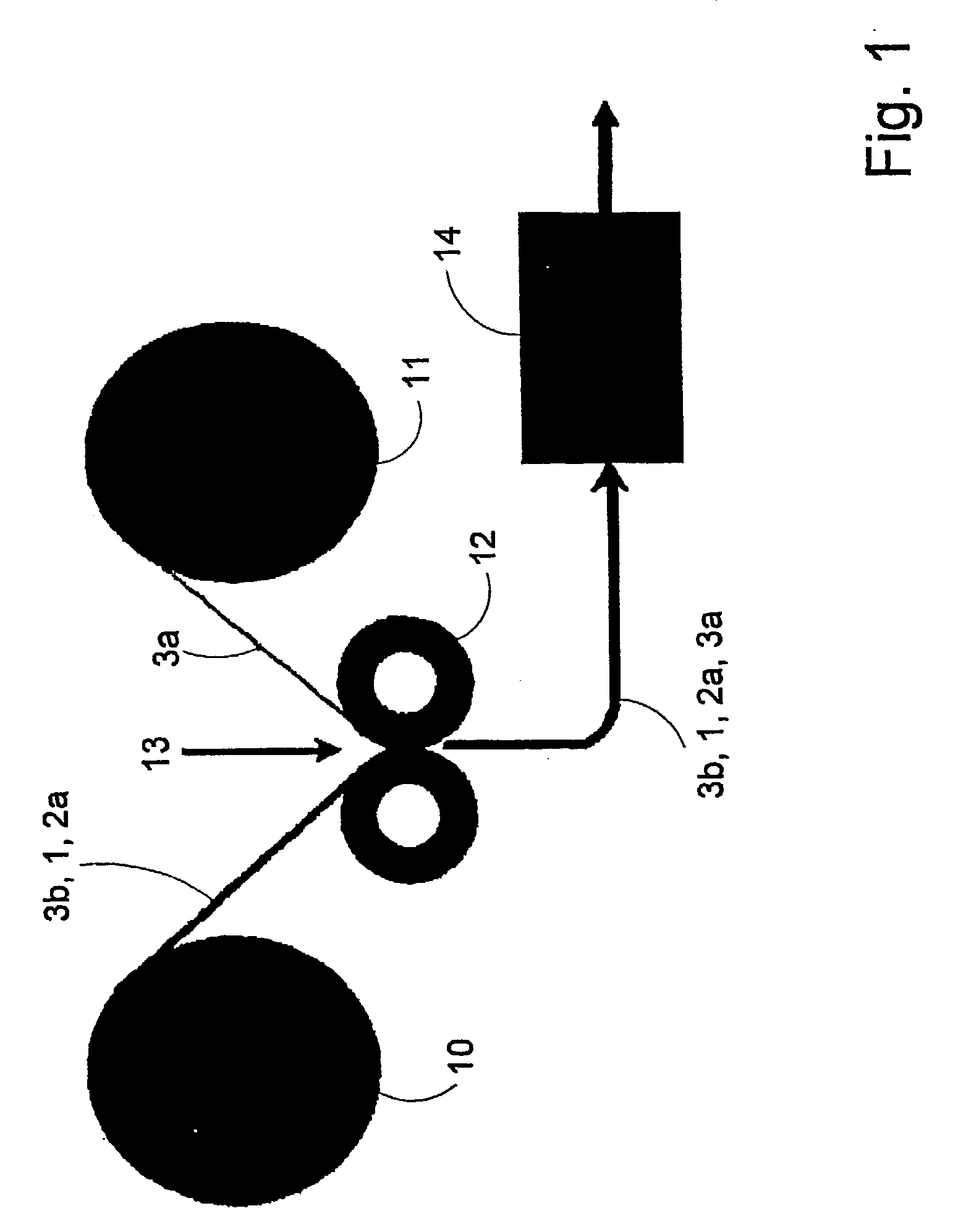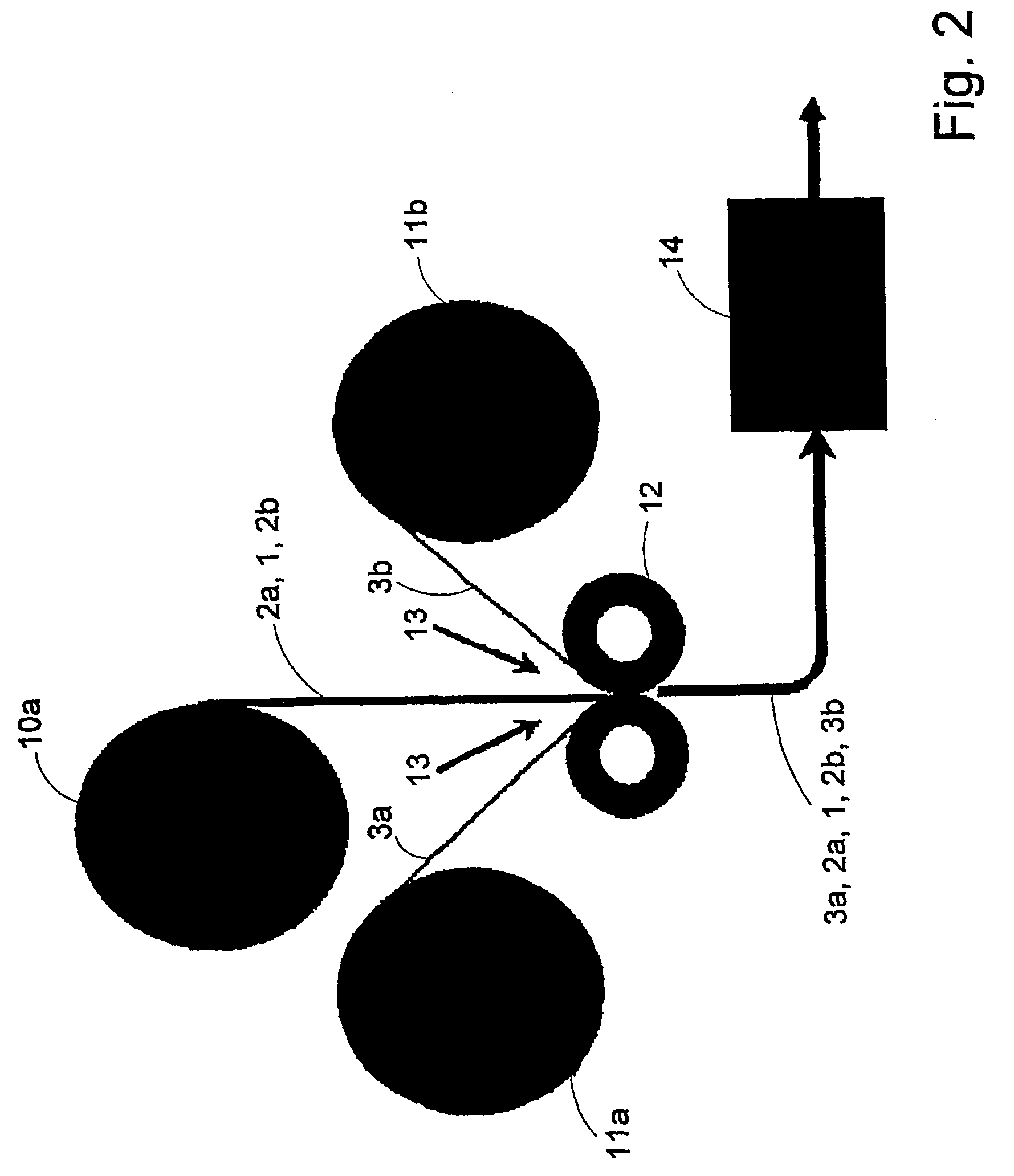Paper or paperboard laminate and method of producing such a laminate
a technology laminate, which is applied in the field of paper or paperboard laminate, can solve the problems of low binder content, difficult to achieve sufficient thickness in the thickness direction, and the single most expensive raw material used in binding
- Summary
- Abstract
- Description
- Claims
- Application Information
AI Technical Summary
Benefits of technology
Problems solved by technology
Method used
Image
Examples
example 1
[0033] FIG. 3
[0034] The laminate L1 according to the embodiment consists of four layers. A thin intermediate layer 2a of paper with a relatively open structure and a secondary layer 3b have been formed together with a bulk layer 1 having the low density and high freeness value typical of the invention. The secondary layer 3b typically comprises a paper layer having a substantially higher density than the bulk layer 1 and also rolled and joined to the bulk layer 1 so that the consolidated laminate acquires the characteristic attributes of the laminate according to the invention. On the same side as the intermediate layer 2a, the laminate in a later stage has had a secondary layer 3a added, which typically comprises a paper layer but can in principle also be composed of a non-fibrous layer, such as a barrier layer, for example a plastic film, metallised plastic film or an aluminium foil of considerably greater density than the bulk layer 1.
example 2
[0035] FIG. 4
[0036] In addition to the layers shown in the laminate L1, FIG. 3, the laminate L2, FIG. 4, comprises a second thin intermediate layer 2b, which adjoins the bulk layer 1 on the opposite side to the intermediate layer 2a, inside the secondary layer 3b. In this case the bulk layer 1 and the two intermediate layers 2a and 2b have been formed together, following which the secondary layers 3a and 3b have been added to the laminate in a later stage. Each secondary layer 3a and 3b typically comprises a paper layer but one of them can in principle also be composed of a non-fibrous layer, such as a barrier layer, for example a plastic film, metallised plastic film or an aluminium foil of considerably greater density than the bulk layer 1.
example 3
[0037] FIG. 5
[0038] The laminate L3, FIG. 5, comprises a composite made up of double the laminate L1 according to FIG. 3, that is to say twice a laminate made up of secondary layers 3b, 3b', bulk layers 1, 1' and intermediate layers 2a, 2a' but without secondary layer 3a. In the construction the two intermediate layers 2a, 2a' have been turned towards one another and joined together, for example in a size press in the same way as shown in FIG. 1. This produces a laminate with double bulk layer, which therefore has a higher basis weight and very good bending stiffness index.
[0039] Account of Experiments Carried Out
[0040] Equipment
[0041] The experiments were carried out on an experimental paper machine (XPM) with a width of approximately 450 mm.
[0042] The equipment used was as follows:
[0043] Conical refiner, type JC 00 (Jylhvaara) for beating of the stock at 4% pulp consistency.
[0044] Fourdrinier wire equipped with three-layer head box. This gives the facility for forming three layers...
PUM
| Property | Measurement | Unit |
|---|---|---|
| density | aaaaa | aaaaa |
| density | aaaaa | aaaaa |
| density | aaaaa | aaaaa |
Abstract
Description
Claims
Application Information
 Login to View More
Login to View More - R&D
- Intellectual Property
- Life Sciences
- Materials
- Tech Scout
- Unparalleled Data Quality
- Higher Quality Content
- 60% Fewer Hallucinations
Browse by: Latest US Patents, China's latest patents, Technical Efficacy Thesaurus, Application Domain, Technology Topic, Popular Technical Reports.
© 2025 PatSnap. All rights reserved.Legal|Privacy policy|Modern Slavery Act Transparency Statement|Sitemap|About US| Contact US: help@patsnap.com



